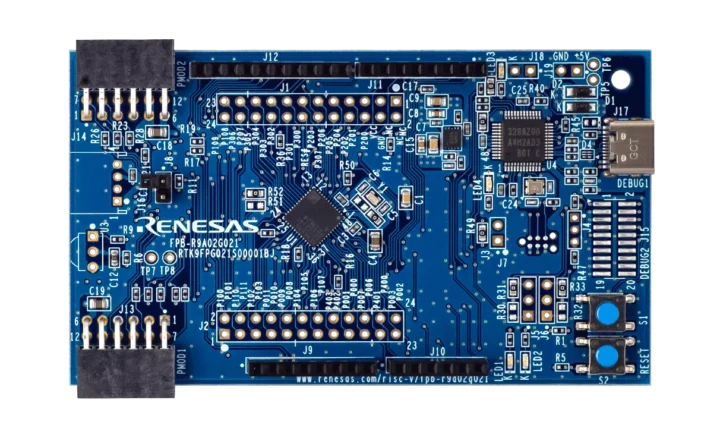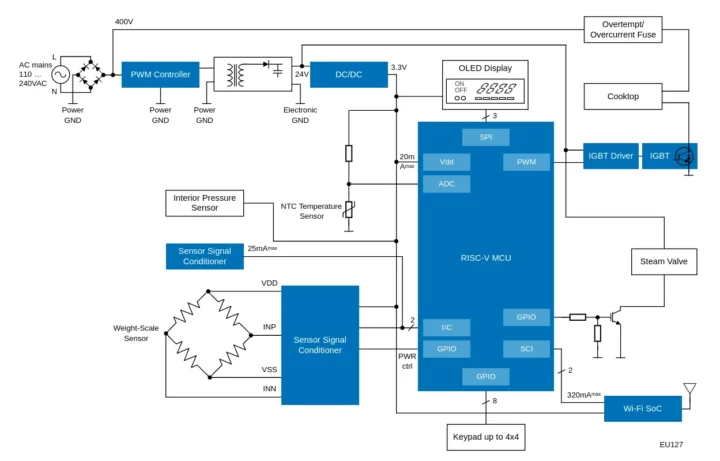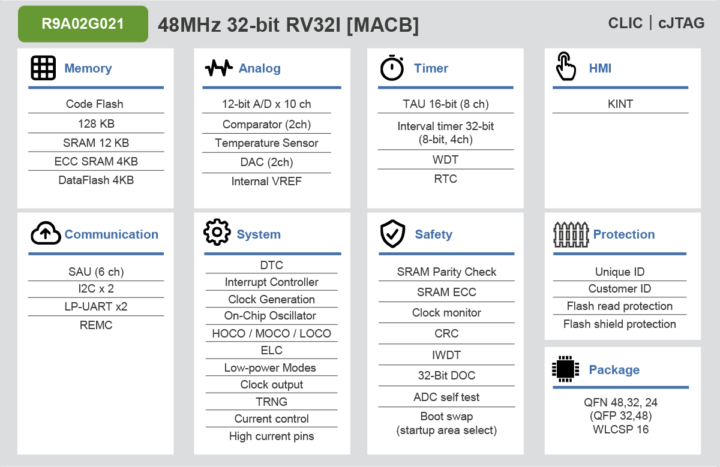Renesas R9A02G021 is the first MCU group to use the company’s in-house designed 32-bit RISC-V CPU core with 3.27 CoreMark/MHz, RV32I base plus M/A/C/B extensions, and features such as a stack monitor register, a dynamic branch prediction unit, and a JTAG debug interface.
Renesas has been making RISC-V chips at least since 2022 with the likes of RZ/Five 64-bit microprocessor and R9A06G150 32-bit voice control ASSP. All those were based on Andes RISC-V cores, but since the company has now designed its own 32-bit core, future Renesas 32-bit RISC-V microcontrollers are all likely to feature the in-house core, starting with the R9A02G021 general-purpose MCU group.
Renesas R9A02G021 key features and specifications:
- RISC-V Core
- Renesas RISC-V instruction-set architecture (RV32I + MACB + Ziscr, Control and Status Register (CSR) instructions + RISC-V Zifencei Instruction-Fetch Fence)
- Maximum operating frequency – 48 MHz
- Debug and Trace – RISC-V External Debug Support
- cJTAG Debug Port
- Memory & storage
- 16 KB SRAM (12KB SRAM and 4KB ECC SRAM)
- 128 KB code flash memory
- 4 KB data flash
- 128-bit unique ID
- I/Os and peripherals
- Up to 42 pins for general I/O ports; open drain, input pull-up
- 6-channel Serial Array Unit (SAU) – 6x simplified SPI, 3x UART, 6x simplified I2C
- 2x I2C, 2x UART
- Remote Control Signal Receiver (REMC)
- Analog
- 12-bit A/D Converter (ADC12)
- 2x comparators (CMP)
- 2x 8-bit D/A converters (DAC8)
- Temperature Sensor (TSN)
- Timers
- Watchdog Timer (WDT)
- Realtime Clock (RTC)
- 8-channel Timer Array Unit (TAU)
- 32-bit Interval Timer (TML32)
- Clock Sources
- External clock input (EXTAL) – 1 to 20 MHz
- Sub-clock oscillator (SOSC) – 32.768 kHz
- High-speed on-chip oscillator (HOCO) – 24/32/48 MHz
- Middle-speed on-chip oscillator (MOCO) – 8 MHz
- Low-speed on-chip oscillator (LOCO) – 32.768 kHz
- Clock trim function for HOCO/MOCO/LOCO
- IWDT-dedicated on-chip oscillator (15 kHz)
- Clock out support
- Safety
- SRAM parity and ECC error check
- Flash area protection
- ADC test function
- Clock Frequency Accuracy Measurement Circuit (CAC)
- Cyclic Redundancy Check (CRC) calculator
- Data Operation Circuit (DOC)
- Independent Watchdog Timer (IWDT)
- GPIO readback level detection
- Register write protection
- Illegal memory access detection
- True Random Number Generator (TRNG)
- System and Power Management
- Operating Voltage – VCC: 1.6 to 5.5V
- Low power modes
- Event Link Controller (ELC)
- Data Transfer Controller (DTC)
- Key Interrupt Function (KINT)
- Power-on reset
- Low Voltage Detection (LVD) with voltage settings
- Power Consumption: 162µA/MHz (Active power), 0.3µA (SW Standby), 4µs (Standby wakeup)
- Packages
- 48-pin HWQFN (7 mm × 7 mm, 0.5 mm pitch)
- 32-pin HWQFN (5 mm × 5 mm, 0.5 mm pitch)
- 24-pin HWQFN (4 mm × 4 mm, 0.5 mm pitch)
- 16-pin WLCSP (1.99 mm × 1.99 mm, 0.4 mm pitch)
- Temperature Range – -40°C to +125°C

Four devices are currently available with different packages from 16-pin WLCSP up to 48-pin HWQFN. Renesas says the new R9A02G021 MCUs are fully supported by the e² Studio Integrated Development Environment (IDE) just like other microcontrollers from the company with a code configurator, an LLVM toolchain, and the fast prototyping board (FPB) pictured above. But third-party tools and debuggers are also supported including IAR Embedded Workbench IDE with the I-jet debug probe and SEGGER Embedded Studio IDE with J-Link debug probes and Flasher production programmers. Documentation includes the FPB user manual, a Getting Started guide, schematics, Bill of Materials (BOM), and Gerber files.
The R9A02G021 group MCUs have no application-specific features like a machine learning accelerator or graphics engine and are designed as general-purpose devices for IoT sensors, consumer electronics, medical devices, small appliances, and industrial systems. To demonstrate its functionality, Renesas developed a smart pressure cooker reference design as part of its “Winning Combinations”.

When I first read the news, I thought IP vendors such as Arm or Andes would have a tough time in the future, as large silicon vendors will develop their own RISC-V cores and related IP, while smaller companies may leverage the existing RISC-V open-source core. So within a few years, the majority of microcontrollers could be RISC-V-based, while RISC-V application processors would ramp up later due to the larger software ecosystem that requires more work. My idea was that maybe in five years RISC-V MCUs would dominate, and RISC-V applications processors in 10 years with a company such as Arm likely to suffer unless they can reinvent themselves.
But I may have been overly optimistic with regards to the timing of RISC-V adoption, as Renesas’ press release quotes “The Microcontroller Market Monitor, 2024 Q1 Edition, Yole Intelligence” with their analyst expecting that “RISC-V should approach 10% of the overall MCU market by the end of 2029 with significant growth potential beyond”.
Some of the Renesas R9A02G021 microcontrollers are available now, with for example, the R9A02G0214CNK (24-pin package) going for $1.27 per unit in 4.9K orders. The Fast Prototyping Board can also be purchased now for $17.29. More details may be found on the product page.

Jean-Luc started CNX Software in 2010 as a part-time endeavor, before quitting his job as a software engineering manager, and starting to write daily news, and reviews full time later in 2011.
Support CNX Software! Donate via cryptocurrencies, become a Patron on Patreon, or purchase goods on Amazon or Aliexpress






Companies will adopt RISC-V where there’s good reason to do so : economics, performance/efficiency, availability and geopolitics.
It’s also encouraging to see silicon design companies eager to use the ISA, and companies like ESP promising pin-for-pin replacement silicon, making adoption easy.